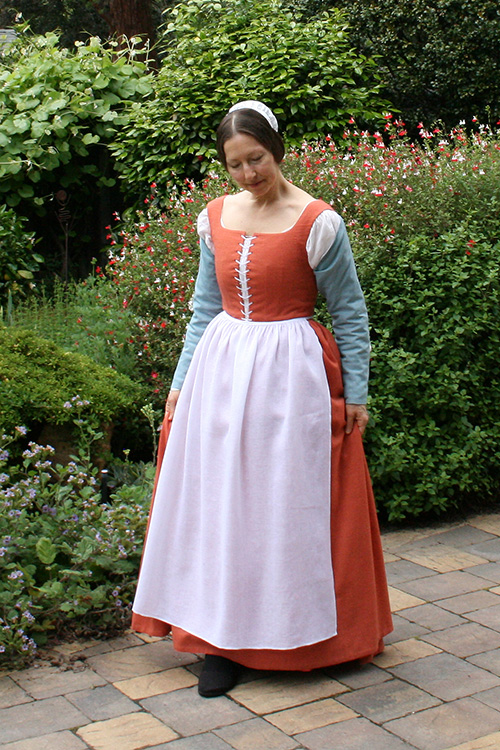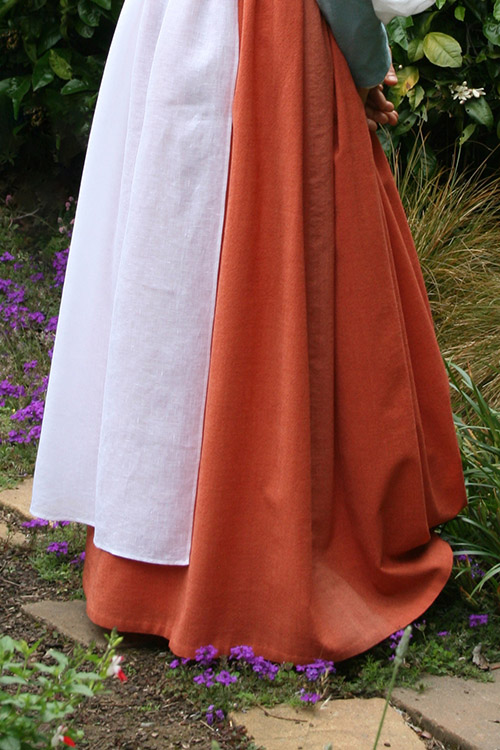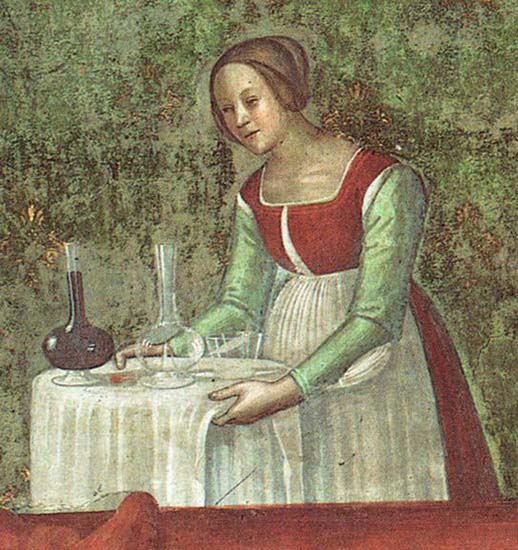
October 2014 – July 2018
A 1490 Florentine servant’s gamurra with partially attached sleeves. The dress is worn with a matching salmon-colored Tudor Tailor petticoat, an Edwardian voile yoke petticoat (in lieu of the long-retired corded petti), a 2.8oz linen camicia, an apron, and a new Florentine cap. All of these have their own write-ups. Festive Attyre and the former website Realm of Venus are both excellent resources for these dresses. Below you’ll find a link to a gallery with some of the images I referenced to make my version.
This light-weight wool was a real bargain and it was ordered online sight unseen. Rather than the red color I was expecting, it showed up as pink. So I haphazardly threw some of the yardage in the washing machine with iDye, and ended up with this nice salmon color. This was far from a complete success however, as the wool changed texture and the selvages didn’t take the dye very well. Several inches on all sides were a completely different shade. At this point the fabric was almost destashed. But I was having difficulties with my Florentine project, so opted to reclaim the wool as a “practice” dress. Nothing to lose, nice and stress-free! With no yardage to spare, I included the undyed parts in the sides of the skirt. They’re somewhat concealed in the folds. But easy to spot once you know it’s there.



The bodice is a curved-front pattern with a 1″ gap at center front. The seams are placed such that the shoulder seam is set behind the shoulder, and the side seam is at the true side. It’s cross-laced through eyelets. Initially I’d intended to make it a raised-waist dress. But that would require a longer skirt and there wasn’t enough fabric. The artwork seems to show everything from a close-to-normal-height waist, to very high. As a servant’s dress, it’s just as well that it’s slightly less fashionable.

One of the reasons this project stalled out was due to my usual dithering. I spent a lot of time experimenting with bodice fabrics and interfacing options. In the end I never really hit on anything that stood out as the perfect solution. So the wool was underlined in broadcloth, with a thin muslin layer for boning and then bag lined. Naturally I’m wearing a bra underneath. A spiral steel at center front supports the eyelets, a few cable ties are spread through the rest of the bodice, and I made no effort to conceal the boning lines. (I’m still on the fence as to whether to try next time.) The bodice is a finished unit. The unlined, cartridge pleated skirt is whipped on.
The two part sleeves are based on the The Tudor Tailor’s basic doublet pattern 4, p. 61. An oval opening was added where the chemise pulls through. They’re made in muted blue silk noil, and lined in batiste. (Personally, I think raw silk is a great stand-in for wool, which is virtually impossible to find in nice period colors). The sleeves are whipped to the back of the shoulder strap. I had no success in arranging the very full chemise so that the sleeve didn’t look stuffed — there’s just too much bulk, even in such a thin linen.



